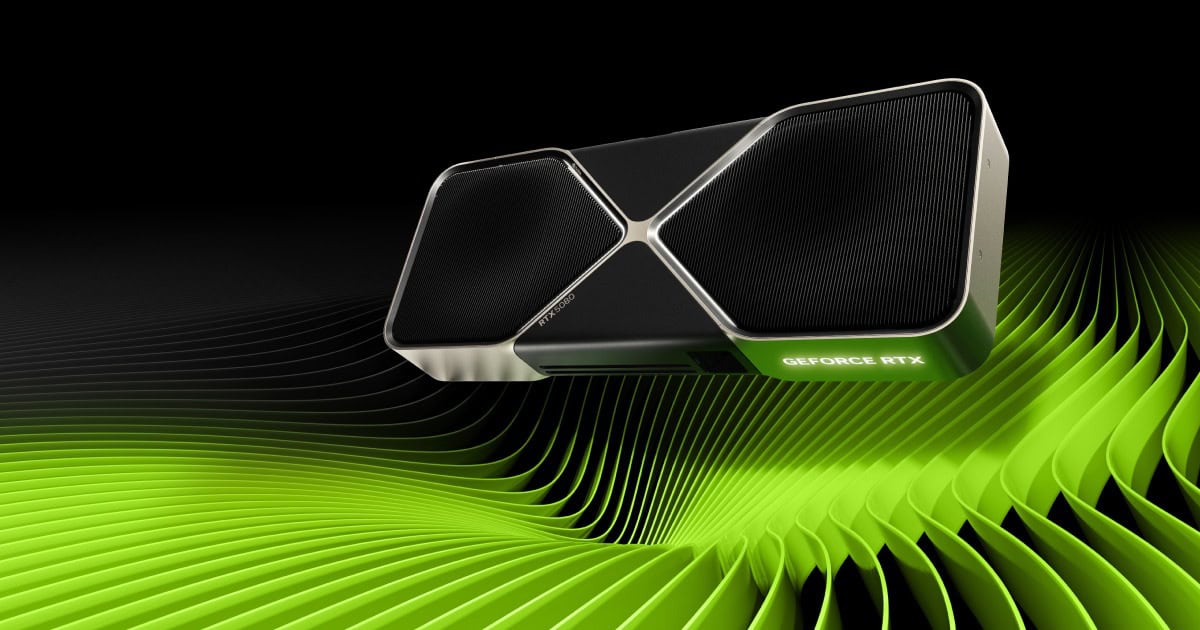The GPU market is buzzing again, and this time, it’s NVIDIA’s rumored GeForce RTX 5080 Super and 5070 Super refreshes stealing the spotlight. Early leaks suggest that NVIDIA is preparing to launch significantly enhanced versions of its upcoming RTX 50-series cards — upgrades that could directly tackle one of the most criticized aspects of the current generation: VRAM limitations.
Both of the cards are expected to be released in late 2025, but nothing is official just yet and the current tariff issue could play into the release date.
Major VRAM Upgrades Incoming
According to multiple leaks from reliable sources, the GeForce RTX 5080 Super could ship with a hefty 24GB of GDDR7 memory, while the RTX 5070 Super is expected to come equipped with 18GB of GDDR7. These aren’t minor tweaks; they represent meaningful jumps over what the base models are anticipated to offer.
- RTX 5080 Super: 24GB GDDR7 (up from an estimated 16GB on the regular RTX 5080)
- RTX 5070 Super: 18GB GDDR7 (up from an estimated 12GB-16GB on the standard 5070)
Higher VRAM isn’t just marketing fluff — it’s crucial for 4K gaming, ray tracing-heavy experiences, modded PC games, and AI workloads that demand more memory bandwidth. It also helps future-proof the cards against increasingly large game asset sizes and demanding professional applications like Blender, Unreal Engine, and Adobe Premiere.
Learning From Past Mistakes
NVIDIA appears to be taking a very different approach compared to the messy rollout of the RTX 40 series. Many gamers still remember the RTX 4080 12GB fiasco, where NVIDIA was heavily criticized for confusing branding and underwhelming specifications relative to price. The backlash forced the company to “unlaunch” the card and reposition it as the RTX 4070 Ti.
With the RTX 50 Super variants, NVIDIA seems more focused on genuine performance improvements rather than simple rebrands. Rather than merely offering slightly higher clock speeds or trivial updates, these new Super cards aim to directly address the real-world needs of gamers, creators, and AI developers who are increasingly running into memory bottlenecks.
Why GDDR7 Matters
Another standout feature of the rumored Super refreshes is the move to GDDR7 memory. Compared to the GDDR6 and GDDR6X used in the RTX 30 and 40 series, GDDR7 promises:
- Higher bandwidth (up to 32 Gbps)
- Better energy efficiency
- Reduced latency
This means that even beyond the increased memory size, users can expect smoother frame rates, faster asset loading, and better multitasking capabilities, particularly when gaming at 4K or when running complex creative workflows.
What to Expect From Performance
While exact performance numbers aren’t available yet, it’s reasonable to expect the RTX 5080 Super to position itself closer to or even surpass the current RTX 4090 in some gaming scenarios, particularly when memory usage is critical. The RTX 5070 Super could emerge as a strong mid-high-end option, offering a lot of what the 5080 Super brings but at a lower price point.
Early speculation hints that clock speeds and CUDA core counts could also get a minor bump, but VRAM and memory bandwidth appear to be the stars of this refresh.
Potential Release Timeline
Although NVIDIA hasn’t officially confirmed the existence of these Super cards, multiple leakers suggest that a mid-2025 release window is possible. That would align with typical NVIDIA product refresh cycles and would make sense if the company wants to stay competitive against AMD’s upcoming RDNA 4 GPUs, which are also expected to feature big memory upgrades.
Comparison Table: RTX 50 Series
| Feature | RTX 5070 | RTX 5070 Super (Rumored) | RTX 5080 | RTX 5080 Super (Rumored) |
|---|---|---|---|---|
| VRAM | 12GB GDDR7 | 18GB GDDR7 | 16GB GDDR7 | 24GB GDDR7 |
| CUDA Cores | 6,144 | TBD | 10,752 | TBD |
| Boost Clock | 2.51 GHz | TBD | 2.62 GHz | TBD |
| Memory Bus Width | 192-bit | 192-bit | 256-bit | 256-bit |
| TDP | 250W | TBD | 360W | TBD |
| Release Date | March 5, 2025 | Late 2025 | January 30, 2025 | Late 2025 |
The rumored RTX 50 Super series could address some of the limitations of the initial RTX 50-series releases, particularly concerning VRAM capacity. While official details are scarce, the potential for enhanced performance makes these upcoming GPUs worth watching for enthusiasts and professionals alike.
Key Takeaways
- The RTX 5080 Super may feature 24GB of VRAM while the 5070 Super could include 18GB, offering substantial memory upgrades.
- These Super variants appear to address previous criticism about insufficient VRAM in current generation cards.
- The refreshed models might launch separately from standard cards, showing NVIDIA’s adjusted strategy based on customer feedback.
GeForce RTX 5080 Super and 5070 Super: Latest Leaks and Official Information
New information has emerged about Nvidia’s upcoming high-end graphics cards. The RTX 5080 Super and RTX 5070 Super are expected to offer significant memory upgrades over their standard counterparts, potentially changing the competitive landscape for PC gaming hardware.
Leaked Specifications and Features
The RTX 5080 Super is reportedly coming with a massive 24GB of memory, a substantial upgrade from the standard model. This information comes from posts on the Chiphell forum by user “panzerlied” who has shared early details about these cards. The memory configuration will likely use larger modules to achieve this capacity.
Similarly, the RTX 5070 Super is expected to feature 18GB of VRAM, utilizing six 3GB modules. This represents a 50% increase over the standard RTX 5070’s 12GB configuration.
Both cards will use Nvidia’s Blackwell architecture, the successor to Ada Lovelace. The GB203 GPU is likely to power these new Super variants, with possibly more CUDA cores and higher clock speeds than their non-Super siblings.
Early performance indicators suggest varying results. One concerning leak indicates the RTX 5080 might be slower than the previous-generation RTX 4090, though this remains unconfirmed.
Expected Release Timeline and Availability
Nvidia appears to be accelerating its Super refresh cycle compared to previous generations. While the company hasn’t officially announced release dates, industry insiders expect these cards to launch in mid-to-late 2025.
Production challenges may affect availability. The larger memory configurations require more advanced manufacturing processes, potentially limiting initial stock. This could lead to another scenario of limited availability at launch.
Board partners like MSI, ASUS, and Gigabyte are likely preparing their custom designs already. These manufacturers typically offer multiple variants with different cooling solutions and factory overclocks.
Supply chain reports suggest Nvidia is securing additional GDDR7 memory supplies to support these high-capacity cards. This indicates the company is planning for substantial production volumes, though actual availability will depend on yield rates and manufacturing efficiency.
Anticipated MSRP and Pricing Strategy
The RTX 5070 Super may target the same $550 MSRP as the standard RTX 5070, despite offering 50% more memory. This pricing strategy would be aggressive compared to previous Super refreshes.
For the RTX 5080 Super, pricing remains less clear. The significant memory upgrade to 24GB suggests a price premium over the standard RTX 5080, possibly positioning it as a “budget” alternative to whatever replaces the RTX 4090.
Market factors will influence actual retail prices:
- Competition from AMD’s next-generation cards
- Crypto mining demand (though this has decreased recently)
- Overall GPU market conditions and demand
- Manufacturing costs for the larger memory configurations
Retailer pricing may differ significantly from MSRP at launch, especially if supplies are limited. Previous launches have seen prices stabilize 3-4 months after initial release.
Design, Cooling Solutions, and Manufacturer Partners
The substantial VRAM increases will affect card designs. Both Super variants will likely require enhanced cooling solutions to manage the additional memory modules and potentially higher power requirements.
Power consumption may increase compared to non-Super cards. While exact TDP values haven’t leaked, the additional memory and potentially higher core counts suggest these cards will draw more power than their standard counterparts.
Reference designs from Nvidia will likely feature the same aesthetic as other RTX 5000 series cards, with the familiar dual-slot design and Founders Edition cooling solution. This cooling system may be enhanced to handle the higher power requirements.
Board partners will offer various designs:
- Water-cooled options from manufacturers like MSI and ASUS
- Triple-fan solutions for improved air cooling
- Factory overclocked models with enhanced power delivery
- Compact designs for smaller case compatibility (though these may be limited)
Physical dimensions will likely increase slightly compared to non-Super variants to accommodate additional cooling needs.
Performance, Hardware Details and Comparisons
The leaked RTX 5080 Super and 5070 Super specifications point to significant hardware improvements over their base variants, with memory configurations and architectural enhancements that could redefine next-generation gaming performance.
Performance Uplift and Benchmark Expectations
The RTX 5080 Super is expected to deliver a 15-20% performance boost over the standard RTX 5080, positioning it as a powerhouse for 4K gaming. This uplift would place it closer to the flagship RTX 5090 in the performance hierarchy.
For the RTX 5070 Super, performance estimates suggest a 10-15% improvement over the base RTX 5070. This would bridge the gap between the RTX 5070 and RTX 5070 Ti, offering gamers a compelling mid-tier option.
Early speculation points to the 5080 Super potentially matching or exceeding the previous generation RTX 4090 in rasterization performance, while the 5070 Super could outperform the RTX 4080 in most gaming scenarios.
Both cards are expected to excel in 1440p and 4K gaming, with the 5080 Super likely becoming the new benchmark for consistent 4K/120Hz gameplay in demanding titles.
Memory Configurations: GDDR7, Bus Width, and VRAM
The RTX 5080 Super is rumored to feature 24GB of GDDR7 memory, a substantial 50% increase over the standard 5080’s 16GB configuration. This memory boost could significantly impact performance in VRAM-hungry applications and future-proof the card for upcoming games.
The RTX 5070 Super is expected to ship with 18GB of GDDR7 memory, compared to the base 5070’s 12GB. This represents an important upgrade for content creators and gamers who work with high-resolution textures.
Both cards will utilize GDDR7 technology, offering higher bandwidth and improved power efficiency over the GDDR6/GDDR6X used in the RTX 40 series. Memory bus widths are rumored to be 384-bit for the 5080 Super and 288-bit for the 5070 Super.
The memory upgrade is particularly notable as it addresses one of the main criticisms of current generation cards: insufficient VRAM for future gaming demands.
Ray Tracing, Path Tracing and DLSS 4 Capabilities
The Super variants are expected to feature enhanced RT cores, potentially offering 25-30% better ray tracing performance than their standard counterparts. This improvement would significantly benefit games implementing full path tracing.
DLSS 4 implementation on these cards should benefit from the increased memory capacity, potentially allowing for higher quality AI upscaling with less performance impact. The additional VRAM will be particularly valuable for storing larger AI models used in frame generation.
Path tracing capabilities should see substantial improvements, with the RTX 5080 Super potentially becoming the first GPU capable of running fully path-traced games at 4K/60fps without requiring DLSS assistance.
Key improvements in RT performance metrics:
- Improved ray-triangle intersection calculations
- Enhanced BVH traversal
- Higher ray budget per frame
- Better denoising algorithms
Comparison to Previous and Competing GPUs
| GPU Model | VRAM | Memory Type | Expected Performance vs RTX 4090 |
|---|---|---|---|
| RTX 5080 Super | 24GB | GDDR7 | +5-10% |
| RTX 5080 | 16GB | GDDR7 | -5-0% |
| RTX 5070 Super | 18GB | GDDR7 | -15-20% |
| RTX 5070 | 12GB | GDDR7 | -25-30% |
Compared to AMD’s current offerings, the RTX 5080 Super would likely maintain Nvidia’s performance lead, with the added benefit of superior ray tracing and AI upscaling technologies.
Against the previous generation, the RTX 5070 Super with its 18GB VRAM configuration could match or slightly exceed the RTX 4080, while offering better power efficiency and newer features.
The memory capacity increases are particularly significant when comparing to current cards: the RTX 5080 Super’s 24GB matches the high-end RTX 4090, while the 5070 Super’s 18GB exceeds even the RTX 4080’s 16GB allocation.
Frequently Asked Questions
NVIDIA’s rumored RTX 5080 Super and 5070 Super models indicate significant memory upgrades compared to previous generations, with leaks pointing to substantially improved specifications.
What improvements can we expect in the performance of the RTX 5080 Super compared to its predecessor?
The RTX 5080 Super is rumored to feature 24GB of memory, which would be a substantial upgrade over the current generation. This memory is expected to use next-generation GDDR7 technology.
Performance improvements will likely come from NVIDIA’s next architecture, possibly offering 30-40% better frame rates in games compared to the RTX 4080. Ray tracing capabilities should see similar improvements.
The card will probably leverage more CUDA cores and higher clock speeds to achieve these performance gains.
How does the RTX 5070 Super compare to its competition in similar price categories?
The RTX 5070 Super with its rumored 18GB memory configuration would position it strongly against AMD’s competing offerings. This represents a 50% memory increase over the standard RTX 4070.
Current leaks suggest it could outperform AMD’s equivalent products in ray tracing and AI-enhanced gaming features like DLSS.
The pricing strategy will ultimately determine its competitive position, as NVIDIA has historically priced their Super variants between standard and Ti models.
What are the anticipated features and capabilities of the 5080 Super and 5070 Super GPUs?
Both cards are expected to utilize GDDR7 memory, offering higher bandwidth and improved power efficiency over current GDDR6X solutions.
Enhanced ray tracing cores (likely 4th generation) and tensor cores should provide better performance in games using these technologies. The RTX 5080 Super’s 24GB memory would be particularly beneficial for content creation and AI tasks.
These cards will likely support the latest display connectivity standards including DisplayPort 2.1 and HDMI 2.1a for higher refresh rates at 4K and 8K resolutions.
When is the expected release date for the RTX 5080 Super and RTX 5070 Super?
While NVIDIA hasn’t officially confirmed these products, industry analysts predict a potential launch in late 2025 or early 2026, following NVIDIA’s typical release pattern.
The standard RTX 5080 and 5070 models would likely release first, with these Super variants following several months later.
Current speculation suggests an introduction of the Super variants could happen around 6-8 months after the initial RTX 50 series launch.
What will be the power consumption and system requirements for the new Super series?
Power requirements for these cards are expected to be similar to or slightly higher than the current generation. The RTX 5080 Super might require 350-400W, while the 5070 Super could need around 250-300W.
Users will likely need at least a 750W power supply for the 5070 Super and 850W+ for the 5080 Super, along with PCIe 5.0 power connectors.
Thermal designs will probably be improved to handle the increased power demands, with larger heatsinks and enhanced cooling solutions.
How do the leaked specifications of the 5080 Super and 5070 Super influence current market predictions?
These leaks suggest NVIDIA is responding to criticism of the RTX 4080 12GB model by offering more generous memory configurations in the next generation.
Market analysts expect these higher-spec models could push average GPU prices upward, as NVIDIA positions these premium offerings above standard models.
Current GPU owners might delay purchases in anticipation of these more powerful options, potentially causing a temporary slowdown in the high-end GPU market.







